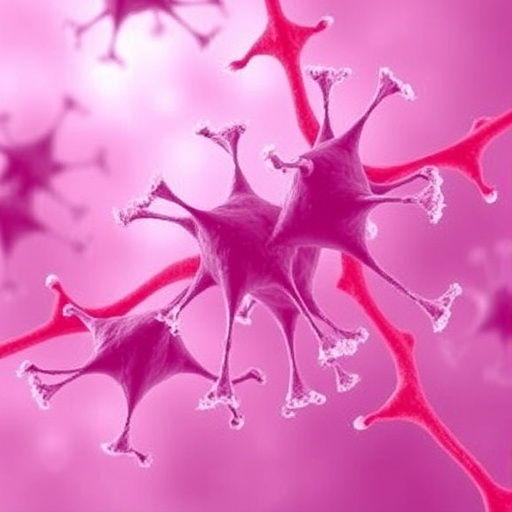In a groundbreaking discovery that bridges the worlds of oncology and regenerative medicine, researchers at Arizona State University have unveiled the dual role of the protein SerpinB3 as both a biomarker for aggressive cancers and a vital component of the body’s natural wound-healing machinery. This protein, historically known for its association with severe diseases such as lung, liver, and skin cancers, now emerges as a key player in epithelial tissue repair, offering promising new directions for treating chronic wounds and combating cancer progression.
SerpinB3, also recognized as squamous cell carcinoma antigen-1, has long been used in clinical diagnostics to indicate aggressive cancer growth and metastasis. For decades, elevated SerpinB3 levels in blood tests have served as ominous markers, signaling the presence of serious malignancies or inflammatory conditions where tissue barriers like skin and lungs are under duress. Despite extensive recognition in oncology, the normal physiological role of this serine protease inhibitor remained elusive until this recent study illuminated its fundamental part in skin regeneration processes.
The study, published in the Proceedings of the National Academy of Sciences, was spearheaded by ASU chemical engineers Jordan Yaron and Kaushal Rege, together with colleagues from the Biodesign Center for Biomaterials Innovation and Translation. Their research involved detailed genetic and molecular analyses of wounded skin tissues, revealing a dramatic surge in SerpinB3 expression within epithelial cells actively migrating into damaged areas. This upregulation indicates that SerpinB3 is not merely a pathological marker but an endogenous injury response element primed to accelerate tissue repair and restore barrier function.
Integral to wound closure, SerpinB3 facilitates the activation of keratinocytes—the predominant cell type in the epidermis responsible for forming new skin layers after injury. By modulating cellular adhesion properties, SerpinB3 enables keratinocytes to detach and migrate efficiently across the wound bed, a critical step in re-epithelialization. This mobility enhancement mirrors effects seen with growth factors such as Epidermal Growth Factor (EGF), yet SerpinB3’s mechanism is distinct, tied closely to its role as a serine protease inhibitor regulating proteolytic activity within the wound microenvironment.
Moreover, the presence of SerpinB3 influences the extracellular matrix remodeling that underpins effective healing. Wounds treated with agents boosting SerpinB3 expression showed markedly improved collagen fiber alignment, reinforcing tissue integrity and mechanical strength. Collagen, a primary structural protein in connective tissue, is essential for providing a scaffold that supports cell proliferation and differentiation during wound repair. Thus, SerpinB3’s involvement extends beyond cellular activation to orchestrating the biochemical milieu needed for skin restoration.
This duality of SerpinB3’s function—both in promoting tissue repair and facilitating cancerous invasion—exemplifies the complex biological balance between regeneration and disease progression. Cancer cells often hijack wound-healing pathways, exploiting proteins like SerpinB3 to enhance their invasiveness and metastasis. Understanding this interplay provides a foundation for developing targeted therapies that can either boost SerpinB3 activity to accelerate healing in patients with chronic wounds or inhibit it to neutralize tumor growth and spread in oncological settings.
Chronic wounds represent a significant healthcare burden, affecting approximately six million patients annually in the United States alone, with costs exceeding $20 billion. These non-healing wounds are especially prevalent in individuals with diabetes, advanced age, infections, or severe burns. By harnessing the natural biological role of SerpinB3, future treatments may more effectively stimulate regeneration where conventional methods have failed, offering hope for millions suffering from persistent ulcerations and pressure sores.
The innovative approach taken by the ASU team also stems from their broader research into bioactive nanomaterials designed for tissue repair. These materials have shown promise in enhancing endogenous repair signals, and the identification of SerpinB3 as a responsive factor within this context underscores its therapeutic potential. Nanomaterial-based wound dressings that amplify SerpinB3 expression could become a new standard in regenerative medicine, combining material science with molecular biology to optimize healing environments.
Further exploration of SerpinB3’s role may extend beyond the skin to other epithelial tissues such as the lungs, where chronic inflammatory diseases also cause significant morbidity. Its involvement in immune regulation and tissue homeostasis suggests that modulating SerpinB3 may prove beneficial in treating diverse pathologies including asthma and other inflammatory conditions, consolidating its position as a pivotal molecular regulator.
Jordan Yaron emphasizes the transformative nature of this discovery: “Our research has illuminated a natural injury response mechanism where SerpinB3 functions as a driver of epithelial regeneration. Recognizing this protein’s bifunctional identity—both as a cancer biomarker and as a healing facilitator—opens new avenues for therapeutic innovation.” His colleague, Kaushal Rege, who directs the Biodesign Center, notes the exciting prospects for translational research aiming to develop SerpinB3-based interventions tailored to specific medical challenges.
In conclusion, this revelation regarding SerpinB3 redefines our understanding of wound healing and cancer biology. It highlights the protein’s integral role within a finely tuned system that balances tissue repair and cellular proliferation. The finding presents compelling opportunities to manipulate this balance, promising improved clinical outcomes for patients with hard-to-heal wounds and aggressive cancers. As research advances, the full therapeutic horizon for SerpinB3 is poised to expand, potentially revolutionizing treatments across multiple medical disciplines.
Subject of Research: Animal tissue samples
Article Title: Squamous cell carcinoma antigen-1/SerpinB3 is an endogenous skin injury response element
News Publication Date: 23-Oct-2025
Web References: https://doi.org/10.1073/pnas.2415164122
References: Proceedings of the National Academy of Sciences, 10.1073/pnas.2415164122
Image Credits: Graphic by Jason Drees/ASU
Keywords: Tissue repair, Diseases and disorders, Cancer immunology, Carcinoma, Lung cancer, Metastasis, Cancer cells, Cancer genomics, Cancer research, Cancer treatments, Neoplasms, Oncology




